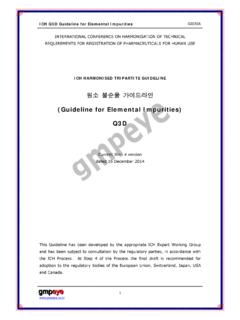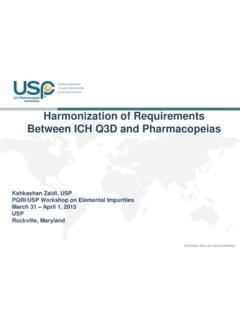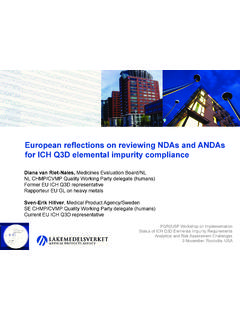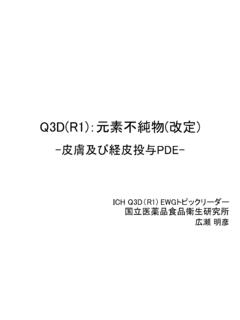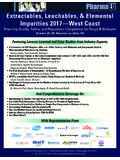Transcription of EI Risk Assessment - European Medicines Agency
1 Elemental Impurity Risk Assessment - Case Studies Author: Andrew Teasdale and Laura Rutter (on behalf of EFPIA). Date: 5 April 2016 * Version: Final 1. Overview Using the principles outlined in ich q3d and training modules we will: Present a series of risk assessments based on actual products. Examining different routes of administration. Through this seek to highlight there is more than one approach, illustrated through the examples shown. Marketing application example summary and proposed location. Approach to products during clinical development. 2. ich q3d Guideline for Elemental Impurities . Practical Implementation of ich q3d . ich q3d recommends taking a risk based approach. Focus is on the final product the fishbone diagram assists by advising on the components for consideration: all potential sources of elemental impurities should be considered and evaluated for their contribution to the drug product.
2 The product Assessment will form the basis of a specific control strategy for EIs and should be available to be presented to Regulators during an inspection upon request. An industry position paper has been jointly authored and published in PharmTech. More Likely Sources Drug Excipients Substance Elemental Impurities in Drug Product . Container Lower Risk Manufacturing Utilities ( , Closure Equipment Water). System 3. Risk Process General Principles Review API, excipient and drug product ich q3d advocates a 3 step process: manufacturing process to identify known and potential sources of Elemental Identify Identify Impurities Evaluate Summarize Control Collect predicted and/or observed levels of elemental impurities Compare data with the established Evaluate Permitted Daily Exposure Different approaches to each stage are now examined through a series of actual risk Summarize and document the risk assessments.
3 Assessment Summarize Identify additional control requirements, if Control required, to ensure PDE is met 4. Industry Risk Assessment Example 1. Synthetic API tablet 5. Industry Risk Assessment Example 1 Oral Solid Dose Product Compound X. Dose Form Tablet Strength 200/ 400 mg compound X. Therapeutic Target (Why patients take this Osteoarthritis product). Dosing Regemine (Frequency & Duration of Daily, one tablet dosing). Maximum Daily Dose of Active 400mg Compound X. Mass of Dosage Unit mg Route of Administration Oral USP Monograph for Product No Site of Manufacture GMP. Packing Site GMP. Elements being Evaluated Class 1 Cd, Pb, AS, Hg Class 2A Co, V, Ni Class 2B Pd Metal catalyst used in API synthesis Class 3 Sn - Hypromellose Additional metals identified by risk 6. Assessment Component Functionality Amount per % in coated Type (Excipient). 400 mg tablet tablet Example 1 Oral Core (mg). Solid Dose API. Drug substance Binder Hypromellose 2910 Plant Diluent Microcrystalline Cellulose Plant Diluent Lactose Monohydrate Animal Disintegrant Crospovidone Synthetic Lubricant Magnesium stearate Mineral Coating Film-former Hypromellose 2910 Plant Pigment Titanium dioxide Mineral Plasticiser Triacetin Synthetic Colorant Blue Aluminium Lake #2 Mineral Colorant Blue Aluminium Lake #1 Mineral 7.
4 Product Information API Synthesis PRE-RSM. O O Y Y'. N NH NH NH. 2. Xylenes, KHCO3, H2 Pd H2O,xylenes 140 C DMF/H2O. X X X. X. Y'' Alk Y'' X Y'' Alk Br N N. N i. NaOH, H2O. Br Alk NBS ii. HBr, THF. X. API. X X. cf. ich q3d : "For biotechnology-derived products, the risks of elemental impurities being present at levels that raise safety concerns at the drug substance stage are considered low."). 8. Product Information drug product manufacture Formulation and components Unit operations Formulation and components Unit operations API Crospovidone Stage 6: Blending Lactose Stage 1: Dry Mix Microcrystalline Cellulose Magnesium stearate Diffusion mixers (tumble). Crospovidone High shear wet granulator Hypromellose Stage 7: Lubrication Stage 2: High Shear Wet Granulation Hypromellose Diffusion mixers (tumble). High shear wet granulator . Purified water Stage 8: Compression Pharmacopeial . Stage 3: Wet Milling Tablet press.
5 Screening Mills . Grade Film Coat Stage 9: Film Coating Stage 4: Fluidised Bed Drying Pan coating Direct heating, fluidised solids bed Stage 10: Packing . Stage 5: Milling Screening mill Section Risk can be Evaluation process not just data driven reduced through process Can be based on first principles. With regards to the process described an evaluation was conducted prior to manufacture understanding / equipment Concluded that risk very low given lack of any extremes of pH and low residence selection / qualification and times. GMP processes. 9. Visual inspection / cleaning also part of GMP. Product Information packaging Drug Substance packaging Drug substance stored in double low density polyethylene bags individually closed with plastic tie wraps. The closed bags are stored inside a rigid outer container/drum. Drug Product packaging X tablets are presented as blister packs formed from unplasticized polyvinyl chloride (PVC) film laminated to a polychlorotrifluoroethene (PCTFE) and sealed to push-through blister foil Risk factors: Contact Solid to Solid no mechanism*.
6 Data relating to PE / PVC show very low EI risk Section Probability of elemental leaching into solid dosage forms is minimal and does not require further consideration in the risk Assessment 10. Step 1 Identify There are multiple ways to conduct an Assessment Review API, excipient and drug product In this example all input materials were manufacturing process to identify known and potential sources of Elemental recorded and a specific risk Assessment Identify Impurities tool used to evaluate each potential EI. source Collect predicted and/or observed levels of elemental impurities Using a pre-defined scoring system. Compare data with the established Evaluate Permitted Daily Exposure This is then represented graphically Summarize and document the risk coding risk in terms of red/amber/green Assessment Summarize Identify additional control requirements, if as well as the numerical risk factor. Control required, to ensure PDE is met 11.
7 Identify Typical high risks : metal catalysts/reagents, mined excipients risks controlled by GMP: purified water, equipment compatibility 12. Identify Evaluation process not just data driven Other factors Can be based on first principles Any risk Assessment needs to be supported by an appropriate IPEC Questionnaire overall quality system. Key aspects of this would typically include: Vendor Assurance Change Control Supplier Information Certificate of Analysis EI risk Assessment In this example for Crospovidone the following information available: Pharmaceutical excipient handbook suggests that a catalyst can be used in the production of crospovidone. Supplier provided a statement to confirm that no metal catalysts are used in the manufacture of their xx grade crospovidone. 13. Step 2 - Evaluate Potential No. of batches to be Elemental l impurities to include in Comments source of metal analysed analytical screening Based on the risk analysis impurities Environmental Intentionally screening requirements were and naturally abundant added' metals metal elements catalysts/reagents defined.
8 Hypromellose 3 batches Class 1: As, Cd, Sn representative of the Hg, Pb Screening focused on Class 1 quality/supplier/grad Class 2A: V, Co, e to be used during and Class 2A metals + Identified commercial Ni manufacture metals. Microcrystalline 3 batches None cellulose Section - 3 production or 6 Lactose 3 batches None monohydrate pilot scale lots Magnesium 3 batches None stearate Analysis performed using fit for Crospovidone None None Addressed through detailed purpose' methodology supplier response Coating 3 batches Class 1: As, Cd, Aluminium lakes Section 9 The determination of EIs should be Hg, Pb are used to colour conducted using appropriate procedures suitable for Class 2A: V, Co, the coating blue. their intended purpose API 3 batches Ni Pd - catalyst 14. Step 2 Evaluate Negligible levels of Class 1 / Class 2A metals across API and excipients tested Potential Elemental impurity concentration in g/g source of Batch elemental Number impurities As Pb Cd Hg V Co Ni Pd Batch 1 < < < < < <5.
9 API Batch 2 < < < < < < <5. Batch 3 < < < < < < <5. Limit of detection ( g/g) 5. Option 2a target limit g/g 23 47 160 78 310 160. ( g/day drug product). 30% Option 2a target limit 14 47 23 94 47. g/g 15. Step 3 Summarize Control - Actions The overall risk to Patients is very low. Intentionally Elemental Acceptable Leached from Control added impurities with a variability of Manufacturing container threshold Element relatively high elemental Action (if used in the equipment closure g/day (30%. environmental impurity systems PDE). process) abundance contribution no further controls required. See control As No Negligible levels No No Yes section for summary of existing controls no further controls required. See control Pb No Negligible levels No No Yes section for summary of existing controls no further controls required. See control Cd No Negligible levels No No Yes section for summary of existing controls Potentially no further controls introduced into required.
10 See control Hg drug substance Negligible levels No No Yes section for summary of with sodium existing controls hydroxide 16. Summarize Control - Actions Elemental Leached Acceptable Intentionally impurities with Control added from variability of threshold a relatively Manufacturing container elemental Action Element high equipment g/day (if used in the closure impurity process) environmental systems contribution (30% PDE). abundance no further controls V No Negligible No No Yes 30 required. See control levels section for summary of existing controls no further controls Co No Negligible No No Yes 15 required. See control levels section for summary of existing controls no further controls Ni No Negligible No No Yes 60 required. See control levels section for summary of existing controls no further controls Catalyst used Negligible required. See control Pd pre-RSM levels in drug No No Yes 30. section for summary of substance existing controls Potentially Negligible no further controls introduced required.










